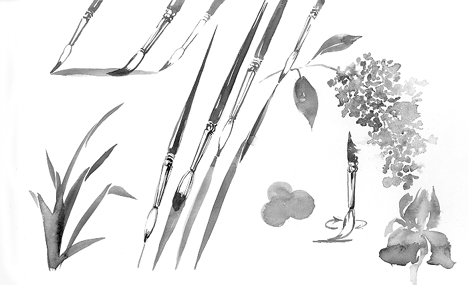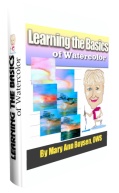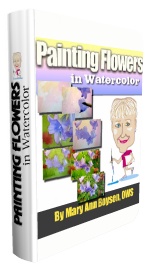By Mary Ann Boysen
Watercolor is an exciting medium that will do the work for the artist, create fascinating nuances, happy surprises when the artist believes he might have made a mistake.
It can be a very transparent or a very opaque final product, depending on the choice of pigments and the method of application. |
Related topics:
Using brushes
Stretching Paper
|
Traditionally it is framed with a mat (to prevent it from touching the glass) and covered with a glazing of glass or Plexiglas to protect the paper and mat from deterioration. The mat, of course, also separates it from its surroundings, like busy wallpaper, or other artwork in the area.
Contrary to the beliefs of many, it is a forgiving medium. Mistakes CAN be corrected, perhaps not as easily as in an oil painting, but that depends on the surface that the artist uses.
Many good watercolor papers are offered on the market. Some make watercolor mistakes easy to correct, and others absorb more of the pigment thereby holding onto the color and resisting the artist's efforts to eliminate their mistakes. Each of these papers has wonderful qualities.
When I want to do many thin glazes of color to build richness in a background, I must choose one of the papers that resist correction. /p>
If I want to paint more directly, maintaining the brilliance of the pure color, then the less absorbent papers are the ones to use. I don't pretend to know everything about every product on the market, but I can give you information on those that I have experienced.
Papers that are absorbent and allow beautiful glazes of color:
- Waterford by T.H. Saunders
- D'Arches
- Fabriano
- Strathmore
NON-Absorbent surfaces that allow corrections with ease:
- Bockingford, a bright white student grade paper made of 100% buffered cotton
- Strathmore Illustration Board 500 Series (paint either side)
- Fredrix Watercolor Canvas (but that is not a paper....and is an entirely different subject, discussed on my Canvas page.)
- Claybord, both smooth and textured.
- R-tistx board- A surface application on PVC that consists of an acrylic base and aluminum oxide with luminous crystals on the 240 and 280. This gives a soft luminous surface to work on that allows pigment to be pushed into layers.
- Yupo, an inert plastic that acts much like smooth Claybord. Totally non-absorbent, but can be stained by staining pigments
The tools of watercolor in order of importance:
- The paper (or surface) on which you paint is the MOST important thing you must consider. Lesser quality papers produce lesser quality paintings, no matter how professional you are.
- Your brushes need not be the finest sable, but they must be of good quality. Round brushes must come to a fine point.
(a) Flat brushes must have a sharp chisel-like edge. (b) Wash brushes must be of a soft bristle, and able to lay a quantity of water over the paper without scratching its surface. The wash brush should also be able to lay color over another color without disturbing the underlying color.
- The color or pigment is the third item to consider. If you are a student and you cannot afford to spend great amounts of money on pure pigment colors, there are good quality paints on the market that you can use. Ask your art supply dealer for help in this area.
For the professional artist who intends to sell his work, he must purchase the higher quality paints, as they are fade resistant, and are graded for permanency. There are many good companies that manufacture the paints that watercolorists use. Winsor-Newton Artists Watercolours, Holbein, Sennelier, Rembrandt, and American Journey (found only in the Cheap Joe's Catalog).
It is up to the artist to test the colors to find his preference. Each year or two, my palette (choice of colors) changes a bit, as I discover new combinations of colors that work for me in a new and different way. It is a challenge. I always share the colors that I am currently using, but encourage the students to make their own choices.
Now, let's begin....
First, you need to get to know your brushes and how they can work for you.
For practice, take a piece of your 100% rag watercolor paper and fold it in half (back and forth until it will tear easily), then repeat this until you have at least 8 small pieces of watercolor paper for exercises. If you use cheap tablets for your exercises, you will not familiarize yourself or your brush with the surface. You need to work on the "real" stuff!
Make circles with your round brush. Dip it into water, then into a juicy mixture of paint. Holding it upright, press the point straight down, then press it down, and twirl it in your fingers.
Make grass strokes with your round brush. Once again, dip your brush in water, then in juicy pigment. Start at the bottom of the page, place the point of the brush on the paper, press it down while you drag it diagonally, and slowly lift it as you drag until it comes to a point. When you get proficient at that, you can do the same stroke, and when you lift the brush at the end of the stroke, back up just a bit beside the last part of the stroke, and do another identical stroke. Be sure to keep the line straight, or it will look like a worm! The grass stroke should appear twisted.

Try painting a flower that grows in clusters, like a hydrangea or lilac. Using a bottle of water, with a trigger type sprayer top, squirt some droplets of water on the paper. Be sure that it is not a "puddle" of water.....just droplets. Then, the the point of your brush that has been dipped into water and pigment, touch the droplets of water and the paint will spread into the droplets. Once this is dry, you can do it again, or you can detail just a few of the little flowerets (but not all of them).
To store your brushes during and after painting, do NOT stand them in water. This will bend the bristles and this will be difficult to correct. Also do not store them with the bristles in the upright position while wet, as the water will run down into the ferrule, and loosen the enamel on the handle, thereby allowing it to crack and peel, and the bristles will be come loose. Lay them on a paper towel to dry.

Enjoy!
Advance to Lesson 2: Value Scale >>
Return to Watercolor Lessons
Watercolor Paintsng Tips
Return to Watercolor Techniques

You can also see the 20 videos of mine on YOUTUBE.
|
My E-Books

Learning the Basics of Watercolor

Painting Flowers in Watercolor

Painting on Watercolor Canvas |

